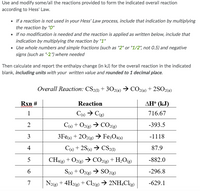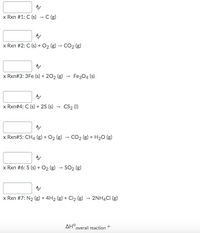
Chemistry
10th Edition
ISBN: 9781305957404
Author: Steven S. Zumdahl, Susan A. Zumdahl, Donald J. DeCoste
Publisher: Cengage Learning
expand_more
expand_more
format_list_bulleted
Question

Transcribed Image Text:Use and modify some/all the reactions provided to form the indicated overall reaction
according to Hess' Law.
• If a reaction is not used in your Hess' Law process, include that indication by multiplying
the reaction by "0"
• If no modification is needed and the reaction is applied as written below, include that
indication by multiplying the reaction by "1"
• Use whole numbers and simple fractions (such as "2" or "1/2", not 0.5) and negative
signs (such as "-2") where needed
Then calculate and report the enthalpy change (in kJ) for the overall reaction in the indicated
blank, including units with your written value and rounded to 1 decimal place.
Overall Reaction: CS2(1) + 302(g) → CO2(g) + 2SO2(g)
Rxn #
Reaction
ΔΗ° (kJ)
1
C(s) → C(g)
716.67
2
C(s) + O2(g) → CO2(g)
-393.5
3
3Fe(s) +202(g) → Fe3O4(s)
-1118
4
C(s) + 2S(s) → CS2(1)
87.9
5
CH4(g) + O2(g) → CO₂(g) + H₂O(g)
-882.0
6
S(s) + O2(g) → SO2(g)
-296.8
N2(g) + 4H2(g) + Cl2(g) → 2NH4Cl(g)
-629.1
7

Transcribed Image Text:x Rxn #1: C (s) → C (g)
A/
x Rxn #2: C (s) + O₂(g) → CO₂ (g)
A/
x Rxn#3: 3Fe (s) + 202 (g) → Fe3O4 (s)
x Rxn#4: C (s) + 2S (s) CS₂ (1)
x Rxn#5: CH4 (g) + O₂ (g) → CO2 (g) + H₂O (g)
-
A/
x Rxn #6: S (s) + O₂(g) → SO₂ (g)
x Rxn #7: N₂ (g) + 4H₂ (g) + Cl₂ (g) → 2NH4Cl (g)
AH overall reaction
=
Expert Solution
This question has been solved!
Explore an expertly crafted, step-by-step solution for a thorough understanding of key concepts.
Step by stepSolved in 2 steps with 2 images

Knowledge Booster
Learn more about
Need a deep-dive on the concept behind this application? Look no further. Learn more about this topic, chemistry and related others by exploring similar questions and additional content below.Similar questions
- 152 A 352.44 155 T 362.31 153 G 355.67 156 X 365.88 154 D 359.12 157 N 369.52 Consider the following reaction: AH = -532.6 kJ ΤΧ Calculate the heat that will be released when 29.87 grams of GX are formed? AG₂+2 XD - AD2 + 2 GXarrow_forwardA chemist measures the energy change ΔH during the following reaction: Cl2(g)+H2(g)→2HCl(g) =ΔH−184.kJ Use the information to answer the following questions. This reaction is... endothermic. exothermic. Suppose 46.0g of Cl2 react. Will any heat be released or absorbed? Yes, absorbed. Yes, released. No. If you said heat will be released or absorbed in the second part of this question, calculate how much heat will be released or absorbed. kJ Round your answer to 3 significant digits.arrow_forwardenthalpy a... A chemist measures the energy change AH during the following reaction: 2 H,O(1) → 2 H,(9)+O%(g) AH=572. kJ Use the information to answer the following questions. endothermic. This reaction is... exothermic. Suppose 90.6 g of H,0 react. Yes, absorbed. Yes, released. Will any heat be released or absorbed? No. If you said heat will be released or absorbed in the second part of this question, calculate how much heat will be released or absorbed. Round your answer to 3 significant digits. Explanation Check MacBook Parrow_forward
- Consider these reactions: Reaction 1: H₂(g) + Cl₂(g) 2HCl(g) AH = -184.6 kJ Reaction 2: 20F2(g) O₂(g) + 2 F₂ (g) ΔΗ = -49.4 kJ Reaction 3: N₂(g) +20₂ (8) 2NO₂(g) ΔΗ = +66.4 kJarrow_forwardConsider the reaction. 2Fe2O3⟶4Fe+3O2 Δ?∘rxn=+824.2 kJ The formation of 77.0 g77.0 g of Fe results in -the absorption of 15900 kJ15900 kJ of heat. -the absorption of 1140 kJ1140 kJ of heat. -the absorption of 284 kJ284 kJ of heat. -the release of 284 kJ284 kJ of heat. -the release of 1140 kJ1140 kJ of heat. -the release of 15900 kJ15900 kJ of heat.arrow_forward6. When 1 g of fuel Y is burned in a bomb calorimeter, the temperature of the calorimeter increases by 8.5 *C. The bomb has a heat capacity of 768 J/ "C and is submerged in 1200 ml of water. What is the heat of combustion of fuel Y in kJ/mole. Molar mass of fuel Y = 78 g/molearrow_forward
- EXPERIMENTAL DATA ΔΗ -55.84 kJ/mol neutralization Mass of dry calorimeter, (g) 126.73 Initial burette reading, (mL) 0.31 Final burette reading, (mL) 14.31 Initial temperature of HCI, (°C) 22.30 Initial temperature of NaOH, (°C) 22.34 Mass of calorimeter and NaCl solution, (g) 156.89 Extrapolated temperature, T;, (°C) 38.26arrow_forward9:15 & a Part 1 Several chemical reactions happen in bioluminescent algae. One of the most important is cellular respiration, which along with photosynthesis helps produce the energy algae need to live. Cellular respiration can be represented by this chemical equation: 60₂ heat 6 CO₂ + 6H₂O + → C6H12O6 + glucose water oxygen carbon dioxide thermal energy 1. Since energy is released in cellular respiration, this reaction is exothermic. Why is the reaction exothermic, not endothermic? To answer this question, draw a model, create a graph, or write an explanation that includes: These materials were developed by the inquiryHub RPP, including educators from CO and IL, Northwestern University and the University of Colorado Boulder, with support from the Hewlett Foundation, the Spencer Foundation, the National Science Foundation and Denver Public Schools. Except where otherwise noted, this work is licensed under the Creative Commons Attribution 4.0 (сс O BY Hub International License. Version…arrow_forward1. A student determines the molar mass of acetone, CH,COH., by the method used in this experiment. She found that the equilibrium temperature of a mixture of ice and water was 0.5°C on her thermometer. When she added 10.5 g if her sample to the mixture, the temperature, fell to -2.6°C. She then poured off the solution through a screen into a beaker. The mass of the solution was 86.4g. d. How much water was in the decanted solution?arrow_forward
- * Ch. 5 Sect 4-5 ~ engine provides 572 Joules In this Push the Pistons. internal energy Chung by Calculate 9 for the represents carried by 1* An automobile of work Process to the -2683 Joules. Engine. This of heat be 300 the amount the cooling Systemarrow_forwardEnthalpy of Combustion (AH): 1. An alcohol is burned, and the heat is transferred to a large calorimeter that contains 3.0 kg of water. This combustion used up 0.285 moles of the alcohol and the temperature of the water to rose by 36.00°C. What is the enthalpy of combustion (AHC) of this alcohol in kJ/mol? (Remember that 1 kg = 1000 g) 2. When 1.20 g of hexane (C6H₁4) are burned, the temperature of 250.0 g of water is raised by 56.0°C. What is the enthalpy of combustion (AHC) of hexane in kJ/mol? 3. Use the following experimental data to determine the enthalpy of combustion of propanol (C3H₂OH) in kJ/mol Mass of water = 200.00 g Initial water temperature = 18.2°C Final water temperature = 38.6°C Initial mass of alcohol lamp = 185.51 g Final mass of alcohol lamp = 184.56 g subtract for massof stuff Know kJofq + mass of stuff 4. A 2.50 g sample of sucrose (C12H22011) was burned in excess oxygen in a bomb calorimeter that was surrou by 2,190 g of water. The temperature of the water…arrow_forwardPlease help me , i need full solution. Please don't provide handwritten solution ..arrow_forward
arrow_back_ios
SEE MORE QUESTIONS
arrow_forward_ios
Recommended textbooks for you
 ChemistryChemistryISBN:9781305957404Author:Steven S. Zumdahl, Susan A. Zumdahl, Donald J. DeCostePublisher:Cengage Learning
ChemistryChemistryISBN:9781305957404Author:Steven S. Zumdahl, Susan A. Zumdahl, Donald J. DeCostePublisher:Cengage Learning ChemistryChemistryISBN:9781259911156Author:Raymond Chang Dr., Jason Overby ProfessorPublisher:McGraw-Hill Education
ChemistryChemistryISBN:9781259911156Author:Raymond Chang Dr., Jason Overby ProfessorPublisher:McGraw-Hill Education Principles of Instrumental AnalysisChemistryISBN:9781305577213Author:Douglas A. Skoog, F. James Holler, Stanley R. CrouchPublisher:Cengage Learning
Principles of Instrumental AnalysisChemistryISBN:9781305577213Author:Douglas A. Skoog, F. James Holler, Stanley R. CrouchPublisher:Cengage Learning Organic ChemistryChemistryISBN:9780078021558Author:Janice Gorzynski Smith Dr.Publisher:McGraw-Hill Education
Organic ChemistryChemistryISBN:9780078021558Author:Janice Gorzynski Smith Dr.Publisher:McGraw-Hill Education Chemistry: Principles and ReactionsChemistryISBN:9781305079373Author:William L. Masterton, Cecile N. HurleyPublisher:Cengage Learning
Chemistry: Principles and ReactionsChemistryISBN:9781305079373Author:William L. Masterton, Cecile N. HurleyPublisher:Cengage Learning Elementary Principles of Chemical Processes, Bind...ChemistryISBN:9781118431221Author:Richard M. Felder, Ronald W. Rousseau, Lisa G. BullardPublisher:WILEY
Elementary Principles of Chemical Processes, Bind...ChemistryISBN:9781118431221Author:Richard M. Felder, Ronald W. Rousseau, Lisa G. BullardPublisher:WILEY

Chemistry
Chemistry
ISBN:9781305957404
Author:Steven S. Zumdahl, Susan A. Zumdahl, Donald J. DeCoste
Publisher:Cengage Learning

Chemistry
Chemistry
ISBN:9781259911156
Author:Raymond Chang Dr., Jason Overby Professor
Publisher:McGraw-Hill Education

Principles of Instrumental Analysis
Chemistry
ISBN:9781305577213
Author:Douglas A. Skoog, F. James Holler, Stanley R. Crouch
Publisher:Cengage Learning

Organic Chemistry
Chemistry
ISBN:9780078021558
Author:Janice Gorzynski Smith Dr.
Publisher:McGraw-Hill Education

Chemistry: Principles and Reactions
Chemistry
ISBN:9781305079373
Author:William L. Masterton, Cecile N. Hurley
Publisher:Cengage Learning

Elementary Principles of Chemical Processes, Bind...
Chemistry
ISBN:9781118431221
Author:Richard M. Felder, Ronald W. Rousseau, Lisa G. Bullard
Publisher:WILEY